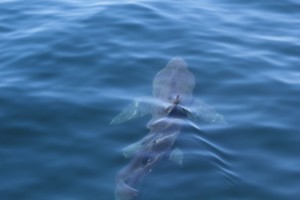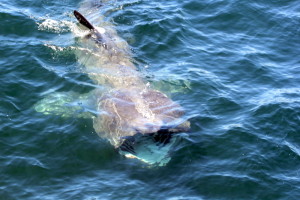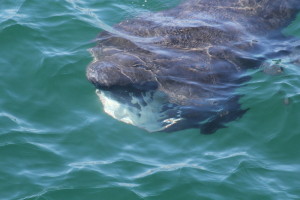Naturalist’s Notebook: June 14 to June 20
As it happens, the largest whale common to the waters around the Cape is the second largest animal ever to have lived on this earth. Finback whales are incredibly large. In the North Atlantic, they can reach lengths between 65 and 75 feet and weigh somewhere around a ton per foot. In the southern hemisphere, they can be as long as 89 feet. The only animal to ever live on earth that is larger than a finback whale is the blue whale (record length of 110 feet and the record weight of 209 tons). By the way, at birth a finner can be just shy of 20 feet and weigh between 2 and 3 tons.
Though, like humpback whales, finback whales are both baleen and rorqual whales, they are shaped very differently from their humpback cousins. Finback whales are long and streamlined animals. They are animals built for speed, capable of acheiving and maintaining speeds up to nearly 30 knots. It was that great speed that protected them from the harpoons of whalers for a very long time. It wasn’t until the inventions of steam-powered vessels and harpoon cannons that fire harpoons with exploding tips that these animals were targetted by the whalers. And, as the populations of the larger blue whales waned, finners became increasingly hunted. Between 1890ish and 1960ish nearly three-quarters of a million finbacks were slaughtered by the whalers.
Finback whales are identifiable (as individuals) by a study of natural markings on the body and of scars. They are unique among mammals in that they exhibit assymetric pigmentation. The left side is colored differently than the right. On the left side, the whale is almost completely the same grey-brown color from one end to the other. Almost. On the right side, the first third of the baleen and the lower jaw are a brilliant white. Behind the blowholes and above the eye, there is a swirling pattern of lighter colored gray and white pigments called the blaze and chevron (a much smaller blaze and chevron are present on the left side but usually are not noticed in any detail from a moving vessel). The patterns of the blaze and chevron (from both sides) are unique to each individual. (Also, the shape and size of the dorsal fin and whether or not there are nicks from either edges.)
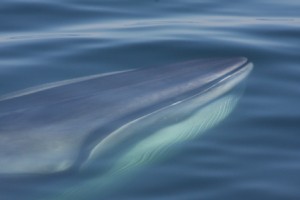
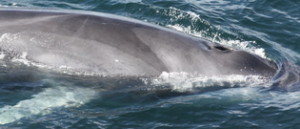
This week, finback whales were spotted on at least a dozen of the twenty-three voyages leaving the Dolphin Fleet floats. On June 16, the finback whales, Skeg and Belt, were identified. And on June 20, two finback whales were seen feeding at the surface. First, they would circle around the school of fish, presumably to corral them closer together, and then lunge through the school at the surface. If you have never seen a feeding finback whale, it is a moment of incredible excitement as a huge wave developes and, from that wave, one side of the open mouth and one flipper and one of the flukes appear. It lasts less than a second (unless you are really lucky) and then it is gone.
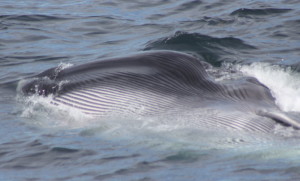
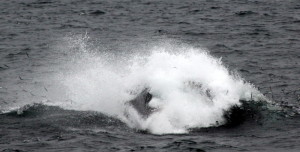
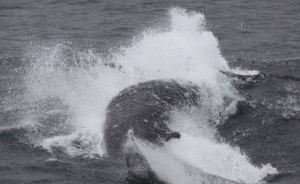

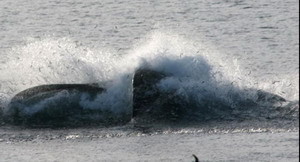
The last two are photos that I took. Hey, you would claim them too.
And,of course, there were humpback whales this week. Of special note was the observation of Spoon nursing her calf on June 14 in glass calm green water. Mark Gilmore reports that “you could see it all.” He further reports that the calf, once finished, got curious about the Dolphin 10 and spent nearly a half-hour passing back and forth beneath it. Similar curiousity was reported by Carolyn OConnor on June 15 about the same calf. In her report, Carolyn says the calf was “tailbreaching very actively.” Spoon and her calf turned up on 16 other trips this week, as well. The calf was not always this active, but on every trip that they were seen on, the naturalist has noted the excitement of the passengers at seeing the antics of the “little” whale.

One of the other items of interest reported about humpback whales this week was an encounter Dennis Minsky had with Nile. He reports that she “let out a stream of urine and fecal matter that was a show in itself.” He adds, “You don’t see that on National Geographic.” This was on June 17 and though no one reported seeing her feeding on that day or previous days, she obviously was.
Minke whales were also reported this week by Carolyn OConnor (June 16), John Conlon (June 16), and Dennis Minsky (June 19). This is not really surprising as minke whales feed on the same types of small, schooling fish as their baleen cousins (humpbacks and finbacks).
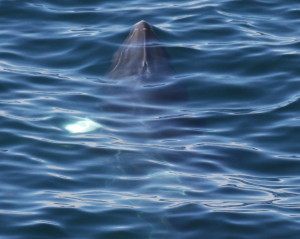
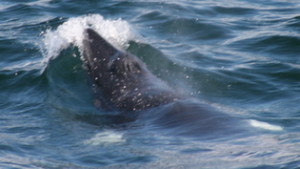
Non-mammal sightings were reported this week as well. The most notable of which was the 25 foot basking shark reported by Carolyn OConnor. Though these animals are the second largest fish living on the planet today, they feed on plankton, like the copepods fed on by Right Whales.
